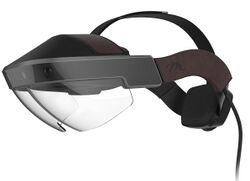Meta 2
Meta 2 is a transparent display headset from Meta. It uses an optical see-through combiner to display images to the user. It specifically supports the Unity game engine. It is compatible with Windows.
It came after the Meta 1.
It was designed in collaboration with frog design.
It is branded as a "natural machine".[1]
Features[edit]
The Meta 2 does positional tracking.[2] Its tracking is laggy and jittery.[3]
Meta 2 provides a new kind of operating environment where you can arrange your holographic apps and objects.[2]
You can lay out your workspace and things stay exactly where you put them.[2]
You and a friend or colleague can even interact with the holograms simultaneously.[2]
The technology has still a long way to go before it can hit the mass market, however. "The sensors and tracking were shaky and didn't capture my hand movements completely. Still, demos of reaching out to pull a shoe from an Amazon webpage to see it in 3D right in front of me or moving videos around the room were impressive," writes Lily Prasuethsut for Wareable.com
Hardware[edit]
Unveiled at TEDx 2016 by Meta CEO Meron Gribetz, the Meta 2 VR headset features a full 90-degree field of view and 2560 x 1440 high-dpi display.[2] The see-through headset makes everything below the eyebrow-level transparent. allowing users to make eye contact with others. The headset itself is lightweight and designed to be as comfortable as possible.[4] Several tech reporters have commented on how well Meta 2 accommodates for people who wear glasses.[5]
As stated by Road to VR, Meta 2 is a tethered gadget which requires the horsepower of a computer to display everything it can.[6] This could prove to be a huge obsticle to success for the company as other VR leader are pushing for untethered solutions. This version of the Meta is tethered to a computer via a 9-foot cable, either HDMI 1.4b or DisplayPort. Eventually the headset will be a standalone device, but like competitors, the technology isn’t quite there at an affordable price.[7]
There’s also a 720p webcam on the front, allowing users to interact in augmented reality space with familiar control methods like a keyboard, or a Web browser.
Technical Specifications[edit]
Meta 2 Tech Specs
- 2550x1440 resolution (60 Hz refresh rate)
- Large field of view (90°)
- Four speaker near-ear audio system
- Nine-foot HDMI cable for video, data & power
- 720p front-facing camera
- Sensor array for hand interactions and positional tracking
- Meta operating environment
Recommended PC Requirements
- Graphics: Nvidia GTX 960 / AMD R9 280
- CPU: Intel Core i7 (desktop CPU)
- Memory: 8GB RAM
- Game Engine: 64-bit Unity 5.3x
- Storage: 10GB
- Video: HDMI 1.4b
- Sound Card: Intel HD-compatible sound card
- USB Ports: USB 3.0
- OS: Windows 8.1 64-bit or newer
Software[edit]
The Meta 2 development kit includes an SDK to build and share tools.[8] Apps built on the Meta 2 Development Kit will be in Unity 3D version 5 or higher.[9]
Customers can go do the Dev Center and scroll to the bottom of the page, where they will see all apps for Meta products available for download.[10] With Meta 2, users can run Windows applications. Mac support is planned for later this year, along with a steady stream of native holographic Meta apps in the months ahead.[2]
Developers can use the freely available SDK to build and share tools. The included Meta 2 SDK is built on top of the most popular 3D engine in the world. Unity enables you to create holographic apps quickly and easily with Unity and C#. The SDK includes SLAM, hands interaction tracking, occlusion, collaboration, neurointerface design guidelines, example code, apps, documentation, and support. Join the largest community of AR developers in the world.[2]
The Meta 2 SDK exe installer can be downloaded from https://s3-us-west-1.amazonaws.com/meta-sdk/MetaSDK2Beta_Installer-2.7.0.38.exe
Accessories[edit]
The Meta 2 development kit is designed to create 3D apps, tools, and experiences. Its open nature makes it possible to integrate with a wide range of accessories.
History[edit]
- On May 17, 2013, Meta launched a crowdfunded Kickstarter campaign.[11]
- In the Fall of 2013, Feiner joined as Lead Advisor.[12]
- In the year G2014, Meta won best heads-up display award for the Meta Pro at the Consumer Electronics Show.[13]
- In January 2015, Meta announced a $23 million Series A round.[14]
- On February 17, 2016, Meta unveiled their second-generation product at TED.[15]
- On June 13, 2016, Meta announced they had raised another $50M in venture funding.[16]
Videos[edit]
{{#ev:youtube|1nXgn7B4-RE|250}} {{#ev:youtube|fjsOhsmRuhE|250}}
References[edit]
- ↑ "Item 296697433677 image". https://i.ebayimg.com/images/g/QSYAAOSwWDtm6P2C/s-l1600.webp.
- ↑ 2.0 2.1 2.2 2.3 2.4 2.5 2.6 https://www.metavision.com/
- ↑ Lang, Ben (2017-04-25). "Watch – Exclusive: Meta 2 AR Demos Revealed in Full". https://www.roadtovr.com/exclusive-meta-2-ar-demos-revealed-full/.
- ↑ http://www.digitaltrends.com/virtual-reality/meta-2-ar-dev-kit/
- ↑ https://www.wareable.com/ar/meta-2-review
- ↑ http://www.roadtovr.com/meta-2-development-kit-hands-on-could-do-for-augmented-reality-what-oculus-rift-dk1-did-for-virtual-reality/
- ↑ http://www.digitaltrends.com/virtual-reality/meta-2-ar-dev-kit/
- ↑ https://buy.metavision.com/products/meta2
- ↑ https://www.metavision.com/faq#meta2-tech-questions
- ↑ https://www.metavision.com/faq#meta-apps-questions
- ↑ https://www.kickstarter.com/projects/551975293/meta-the-most-advanced-augmented-reality-interface
- ↑ http://www.usatoday.com/story/tech/2013/07/29/change-agents-meron-gribetz-meta-3d-glasses/2579315/
- ↑ http://www.forbes.com/pictures/fdef45mdfe/meron-gribetz-28-2/
- ↑ http://blogs.wsj.com/venturecapital/2015/01/28/augmented-reality-headset-maker-meta-secures-23-million/
- ↑ http://uploadvr.com/meta-2-ar-glasses-ted/
- ↑ https://techcrunch.com/2016/06/13/meta-raises-another-50m-as-it-gears-up-for-the-next-version-of-its-ar-headset-and-china/
